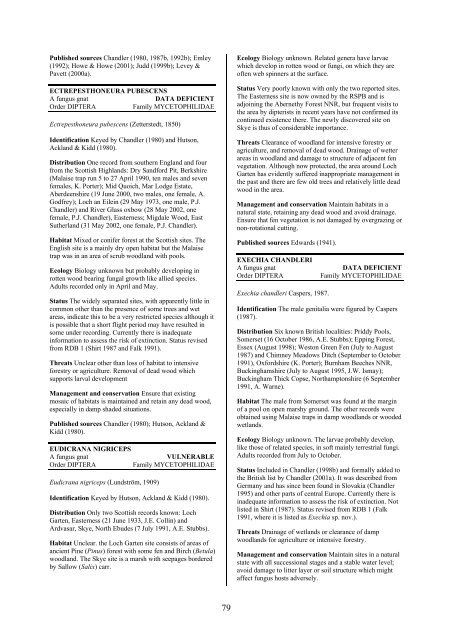Part 2: Nematocera and Aschiza not dealt with by Falk (1991) - JNCC
Part 2: Nematocera and Aschiza not dealt with by Falk (1991) - JNCC
Part 2: Nematocera and Aschiza not dealt with by Falk (1991) - JNCC
Create successful ePaper yourself
Turn your PDF publications into a flip-book with our unique Google optimized e-Paper software.
Published sources Ch<strong>and</strong>ler (1980, 1987b, 1992b); Emley<br />
(1992); Howe & Howe (2001); Judd (1999b); Levey &<br />
Pavett (2000a).<br />
ECTREPESTHONEURA PUBESCENS<br />
A fungus gnat<br />
DATA DEFICIENT<br />
Order DIPTERA<br />
Family MYCETOPHILIDAE<br />
Ectrepesthoneura pubescens (Zetterstedt, 1850)<br />
Identification Keyed <strong>by</strong> Ch<strong>and</strong>ler (1980) <strong>and</strong> Hutson,<br />
Ackl<strong>and</strong> & Kidd (1980).<br />
Distribution One record from southern Engl<strong>and</strong> <strong>and</strong> four<br />
from the Scottish Highl<strong>and</strong>s: Dry S<strong>and</strong>ford Pit, Berkshire<br />
(Malaise trap run 5 to 27 April 1990, ten males <strong>and</strong> seven<br />
females, K. Porter); Mid Quoich, Mar Lodge Estate,<br />
Aberdeenshire (19 June 2000, two males, one female, A.<br />
Godfrey); Loch an Eilein (29 May 1973, one male, P.J.<br />
Ch<strong>and</strong>ler) <strong>and</strong> River Glass oxbow (28 May 2002, one<br />
female, P.J. Ch<strong>and</strong>ler), Easterness; Migdale Wood, East<br />
Sutherl<strong>and</strong> (31 May 2002, one female, P.J. Ch<strong>and</strong>ler).<br />
Habitat Mixed or conifer forest at the Scottish sites. The<br />
English site is a mainly dry open habitat but the Malaise<br />
trap was in an area of scrub woodl<strong>and</strong> <strong>with</strong> pools.<br />
Ecology Biology unknown but probably developing in<br />
rotten wood bearing fungal growth like allied species.<br />
Adults recorded only in April <strong>and</strong> May.<br />
Status The widely separated sites, <strong>with</strong> apparently little in<br />
common other than the presence of some trees <strong>and</strong> wet<br />
areas, indicate this to be a very restricted species although it<br />
is possible that a short flight period may have resulted in<br />
some under recording. Currently there is inadequate<br />
information to assess the risk of extinction. Status revised<br />
from RDB 1 (Shirt 1987 <strong>and</strong> <strong>Falk</strong> <strong>1991</strong>).<br />
Threats Unclear other than loss of habitat to intensive<br />
forestry or agriculture. Removal of dead wood which<br />
supports larval development<br />
Management <strong>and</strong> conservation Ensure that existing<br />
mosaic of habitats is maintained <strong>and</strong> retain any dead wood,<br />
especially in damp shaded situations.<br />
Published sources Ch<strong>and</strong>ler (1980); Hutson, Ackl<strong>and</strong> &<br />
Kidd (1980).<br />
EUDICRANA NIGRICEPS<br />
A fungus gnat<br />
VULNERABLE<br />
Order DIPTERA<br />
Family MYCETOPHILIDAE<br />
Eudicrana nigriceps (Lundström, 1909)<br />
Identification Keyed <strong>by</strong> Hutson, Ackl<strong>and</strong> & Kidd (1980).<br />
Distribution Only two Scottish records known: Loch<br />
Garten, Easterness (21 June 1933, J.E. Collin) <strong>and</strong><br />
Ardvasar, Skye, North Ebudes (7 July <strong>1991</strong>, A.E. Stubbs).<br />
Habitat Unclear. the Loch Garten site consists of areas of<br />
ancient Pine (Pinus) forest <strong>with</strong> some fen <strong>and</strong> Birch (Betula)<br />
woodl<strong>and</strong>. The Skye site is a marsh <strong>with</strong> seepages bordered<br />
<strong>by</strong> Sallow (Salix) carr.<br />
Ecology Biology unknown. Related genera have larvae<br />
which develop in rotten wood or fungi, on which they are<br />
often web spinners at the surface.<br />
Status Very poorly known <strong>with</strong> only the two reported sites.<br />
The Easterness site is now owned <strong>by</strong> the RSPB <strong>and</strong> is<br />
adjoining the Abernethy Forest NNR, but frequent visits to<br />
the area <strong>by</strong> dipterists in recent years have <strong>not</strong> confirmed its<br />
continued existence there. The newly discovered site on<br />
Skye is thus of considerable importance.<br />
Threats Clearance of woodl<strong>and</strong> for intensive forestry or<br />
agriculture, <strong>and</strong> removal of dead wood. Drainage of wetter<br />
areas in woodl<strong>and</strong> <strong>and</strong> damage to structure of adjacent fen<br />
vegetation. Although now protected, the area around Loch<br />
Garten has evidently suffered inappropriate management in<br />
the past <strong>and</strong> there are few old trees <strong>and</strong> relatively little dead<br />
wood in the area.<br />
Management <strong>and</strong> conservation Maintain habitats in a<br />
natural state, retaining any dead wood <strong>and</strong> avoid drainage.<br />
Ensure that fen vegetation is <strong>not</strong> damaged <strong>by</strong> overgrazing or<br />
non-rotational cutting.<br />
Published sources Edwards (1941).<br />
EXECHIA CHANDLERI<br />
A fungus gnat<br />
Order DIPTERA<br />
Exechia ch<strong>and</strong>leri Caspers, 1987.<br />
DATA DEFICIENT<br />
Family MYCETOPHILIDAE<br />
Identification The male genitalia were figured <strong>by</strong> Caspers<br />
(1987).<br />
Distribution Six known British localities: Priddy Pools,<br />
Somerset (16 October 1986, A.E. Stubbs); Epping Forest,<br />
Essex (August 1998); Weston Green Fen (July to August<br />
1987) <strong>and</strong> Chimney Meadows Ditch (September to October<br />
<strong>1991</strong>), Oxfordshire (K. Porter); Burnham Beeches NNR,<br />
Buckinghamshire (July to August 1995, J.W. Ismay);<br />
Buckingham Thick Copse, Northamptonshire (6 September<br />
<strong>1991</strong>, A. Warne).<br />
Habitat The male from Somerset was found at the margin<br />
of a pool on open marshy ground. The other records were<br />
obtained using Malaise traps in damp woodl<strong>and</strong>s or wooded<br />
wetl<strong>and</strong>s.<br />
Ecology Biology unknown. The larvae probably develop,<br />
like those of related species, in soft mainly terrestrial fungi.<br />
Adults recorded from July to October.<br />
Status Included in Ch<strong>and</strong>ler (1998b) <strong>and</strong> formally added to<br />
the British list <strong>by</strong> Ch<strong>and</strong>ler (2001a). It was described from<br />
Germany <strong>and</strong> has since been found in Slovakia (Ch<strong>and</strong>ler<br />
1995) <strong>and</strong> other parts of central Europe. Currently there is<br />
inadequate information to assess the risk of extinction. Not<br />
listed in Shirt (1987). Status revised from RDB 1 (<strong>Falk</strong><br />
<strong>1991</strong>, where it is listed as Exechia sp. nov.).<br />
Threats Drainage of wetl<strong>and</strong>s or clearance of damp<br />
woodl<strong>and</strong>s for agriculture or intensive forestry.<br />
Management <strong>and</strong> conservation Maintain sites in a natural<br />
state <strong>with</strong> all successional stages <strong>and</strong> a stable water level;<br />
avoid damage to litter layer or soil structure which might<br />
affect fungus hosts adversely.<br />
79
















